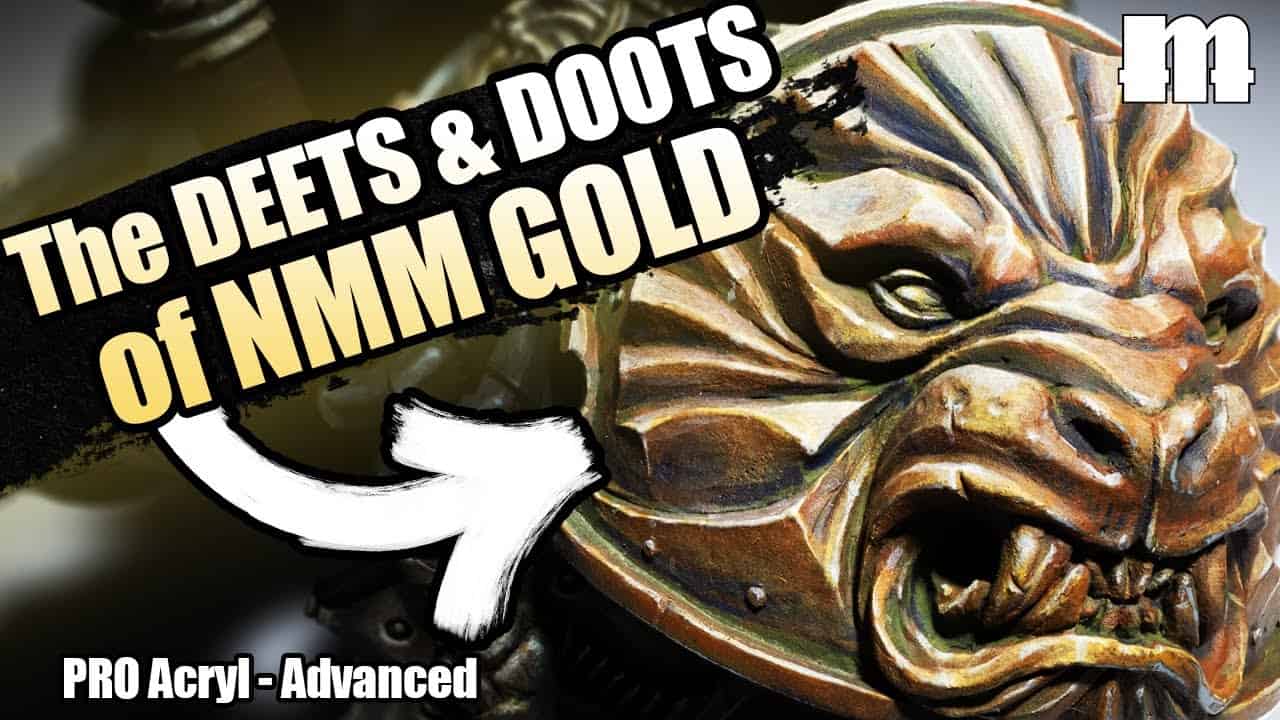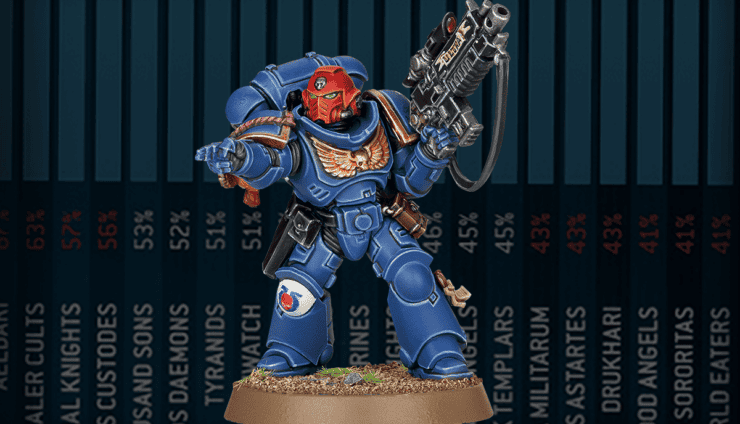Learn how to paint NMM gold on miniatures with expert techniques from Monument Hobbies, covering color choices, layering tips and more!
Getting gold to shine on minaitures without a single drop of metallic paint might sound impossible, but it’s all about technique. Non-metallic metal (NMM) gold is a game of contrast, color placement, and smooth layering. Done right, it creates the illusion of reflective metal using nothing but standard paints and smart lighting tricks.
This guide breaks down how to paint NMM gold step by step, using expert techniques straight from Monument Hobbies. From selecting the right colors to layering shadows and highlights, everything here is designed to make gold armor, weapons, and details look like real metal, whether on Warhammer miniatures or for other games
Here’s how to do it.
Introduction to Non-Metallic Metal (NMM) Gold
Painting gold without using metallic paint? Sounds like a magic trick, right? But it’s not—it’s just a technique called non-metallic metal (NMM) gold. Instead of relying on shiny pigments, this approach uses carefully placed highlights and shadows to create the illusion of reflective metal.
The key is contrast. The brighter your highlights and the deeper your shadows, the shinier the effect. Light placement is everything, so understanding where your imaginary light source is hitting the model will make or break the illusion.
What is NMM Gold?

It’s less about what’s in your paint pot and more about how you apply it. The goal? Sharp, bold contrasts—deep shadows, glowing midtones, and razor-thin highlights. Get those right, and suddenly, your flat paint job looks like polished metal.
Why Use NMM for Warhammer 40k Models?
So why go through all this effort when metallic paints exist? Simple—control and style. Metallic paints reflect real light, which can sometimes make small details hard to see. With NMM, you dictate where the shine appears, making the model pop under any lighting.
It also creates a more painterly, high-contrast look that stands out beautifully, especially for Warhammer 40k miniatures. Whether it’s ornate armor or an ancient relic, learning how to paint NMM gold gives your models a unique, hand-crafted finish. Plus, nothing says bragging rights like achieving a flawless golden shine without a single drop of metallic paint.
Since this post is from Monument, all the paints used in the tutorial are from them. So be sure to snag any of the linked paints in the video and give us a high-five in support! Every qualifying purchase helps Spikey Bits keep the lights on and the fun going.
The Six-Color Workup for NMM Gold
Getting a rich, reflective look without a single drop of metallic paint sounds tricky, but a solid color workup makes all the difference. The key to mastering how to paint NMM gold lies in layering the right colors to create depth, warmth, and contrast. A strong foundation sets up everything, and the right highlights pull it all together.
Choosing the Right Paint Colors
Gold isn’t just yellow with highlights—it’s a mix of warm, cool, and deep tones that play off each other. Starting with dark yellow-green gives the base a slightly aged, muted foundation. It won’t look like gold yet, but don’t panic. Shadows get punched in with dark purple, adding richness and separating light from dark areas.
For the first hit of warmth, orange oxide comes into play. This adds depth and makes the future highlights pop. Moving up the scale, orange-brown bridges the gap between shadows and midtones, giving the model that signature golden hue.
To start making things shine, bright yellow ochre lays the groundwork for highlights, bringing in a more classic gold tone. The final touch? Bright pale yellow, carefully placed on edges and raised surfaces, creating that crisp metallic effect.
Layering & Blending for a Realistic NMM Effect
The process starts with a full coat of dark yellow-green, covering every area meant to be gold. Once that’s set, dark purple goes into the shadows, focusing on recesses and undersides. A messy application works since later layers will refine everything.
Orange oxide gets dry brushed over raised areas, pulling warmth into the surface. Then, orange-brown smooths transitions, while yellow ochre starts defining reflective spots. The final step is bright pale yellow, carefully applied to edges and high points to give that polished metal effect.
Step-by-Step Process for Painting NMM Gold

Step 1 – Establishing the Base with Dark Yellow-Green

Step 2 – Creating Depth with Dark Purple Shadows

Step 3 – Warm Undertones with Orange Oxide

Step 4 – Enhancing Midtones with Orange-Brown

Step 5 – Highlighting with Bright Yellow Ochre

Step 6 – Adding the Final Shine with Bright Pale Yellow

Tips & Techniques for Achieving the Best NMM Gold Effect
Painting non-metallic gold is all about tricking the eye. Since there’s no actual shine in the paint, the illusion comes from bold contrasts, sharp highlights, and a solid understanding of how light interacts with different surfaces. Figuring out how to paint NMM gold means getting comfortable with pushing values from deep shadows to near-white highlights while keeping everything blended smoothly.
Understanding Light Reflection on Gold Surfaces

When mapping out reflections, think about where your light source is coming from. The brightest highlights should be placed directly in line with the light, while shadows sit opposite. Since gold has a warm tone, reflections often have a yellow or orange tint rather than pure white.
Using Environment-Based Shadows for Realism
A reflective object doesn’t just show its own color—it picks up hints of the environment. This is why adding a mix of purples, oranges, and greens in the shadows can make non-metallic gold feel more natural. Dark purple is especially useful because it provides depth while still feeling rich and vibrant. Orange oxide helps bridge the transition into brighter tones, keeping everything warm and cohesive.
If the model is in a dark, grimy setting, shadows might lean cooler, with hints of green or desaturated tones. In a warmer scene, shadows could carry more red or burnt orange. Small adjustments like this create a stronger sense of realism, making the gold feel like it exists within a believable space rather than floating in a vacuum.
The Importance of Edge Highlighting in NMM Gold

The trick is knowing where to place these highlights. Edges that face the light directly should be the brightest, while those in shadow can be softer but still visible. If every edge is highlighted the same way, the gold starts looking flat rather than reflective.
Common Mistakes to Avoid When Painting NMM Gold
One of the most common issues is overblending. While blending is important, too much can remove the sharp transitions that make metal look reflective. If the gold looks like smooth fabric instead of polished metal, it’s time to sharpen some edges.
Another mistake is placing highlights incorrectly. If a bright spot appears in the wrong place, the whole illusion falls apart. Before committing to highlights, take a step back and check if they make sense with the light source.
Rushing the process also leads to problems. Layering gradually and allowing each stage to build up creates a much stronger result than trying to get the effect all at once. Patience is the key to making non-metallic gold shine.
Advanced NMM Gold Techniques for Large & Small Models

Adjusting NMM Gold for Different Model Sizes

Larger models need more nuance. Broad surfaces without enough variation can look flat. This is where extra steps come in. More midtone transitions, additional glazes, and refined highlight placement keep the surface interesting. Expanding the color range with more subtle shifts between orange-brown, yellow ochre, and pale yellow adds realism.
How to Make NMM Gold Look More Lifelike
A reflective surface isn’t just one solid color. It picks up hints of the environment, which is where subtle color variation comes in. Adding grays, reds, and purples into the shadows creates a more organic look. A dark purple shadow can suggest cooler lighting, while burnt reds can mimic reflections from surrounding objects.
Not all gold needs to look the same. A warrior’s armor might have a polished, regal shine, while a weapon hilt could have a slightly duller, aged appearance. Tweaking the color mix based on the surface tells a better story and makes the model feel more realistic.
FAQs About Painting NMM Gold

What’s the Best Way to Start Painting NMM Gold?
The best way to start is by focusing on contrast. Gold isn’t just yellow with a few highlights—it’s a balance of deep shadows, midtones, and bright reflections. A dark yellow-green base sets the foundation, while dark purple shadows add richness. Orange oxide and orange-brown bring warmth before layering on yellow ochre and bright pale yellow for the final shine.
Blocking out light and shadow areas early helps avoid confusion later. It might look rough at first, but once highlights are placed, the illusion starts working.
Can You Use This Technique on Other Metallic Colors?
Absolutely. The method works for silver, copper, bronze—any metal effect you need. The difference comes in color choices. For steel, start with a dark blue-gray base, push shadows with dark blue or black, and highlight with light gray and white. Copper benefits from red-brown and orange tones, while bronze works well with deep green shadows and warm gold highlights.
The key is the same: contrast, edge highlights, and proper light placement.
How Do You Avoid Making NMM Gold Look Too Flat?
One of the biggest mistakes is blending too much. Gold has sharp reflections, so keeping highlights crisp makes a big difference. Instead of fading every layer smoothly, let some transitions be more defined.
Another trick is using a variety of colors in the shadows. Purples, blues, or deep reds make shadows more dynamic, giving the gold a more realistic look. Adding reflected light on lower edges also helps, reinforcing the illusion of metal catching light from multiple angles.
What Brushes and Paints Work Best for NMM Gold?
A fine detail brush is essential for edge highlights and reflections, while a soft round brush works well for blending midtones. Synthetic or sable brushes both work, depending on preference.
For paints, anything with good opacity and smooth blending works. Dark yellow-green, dark purple, orange oxide, orange-brown, yellow ochre, and bright pale yellow are excellent starting points. Thinning paint slightly with water or glaze medium helps build smooth layers without losing control.
Final Thoughts on Painting NMM Gold

It might look messy at first, but trust the process. Each layer brings more depth, and once those final highlights go on, the gold effect clicks into place. Take your time, experiment with color variations, and don’t be afraid to push the contrast.
Go Grab Your Monument Hobbies Paints Here!






